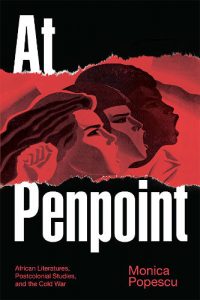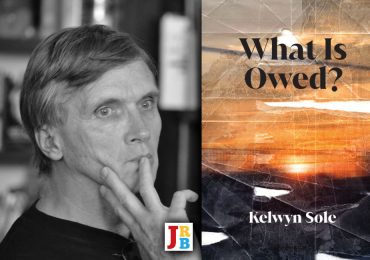Monica Popescu’s At Penpoint: African Literatures, Postcolonial Studies, and the Cold War is a steadfast engagement with the cultural Cold War’s impact on African literary studies, writes Bhakti Shringarpure.

At Penpoint: African Literatures, Postcolonial Studies, and the Cold War
Monica Popescu
Duke University Press, 2020
Monica Popescu’s At Penpoint: African Literatures, Postcolonial Studies, and the Cold War is an important and comprehensive addition to the steady trickle of books on what is called ‘the cultural Cold War’. The title pays homage to Ngũgĩ wa Thiong’o’s ideas about postcolonial writing’s role in striking back at imperialism. Popescu explains that such writing, taking place at ‘penpoint’, meant ‘storming the literary metropolises of empires old and new with writing implements instead of guns’ and that these ‘authors underlined the urgency of the project to decolonise aesthetic canons’.
However, the story of postcolonial cultural production is nested within the larger story of the Cold War. When the Cold War and literature connection is evoked, some may recall John le Carré’s spy novels or Matt Damon playing poetry-loving Yale literature major-turned-spy in The Good Shepherd. Others might vaguely remember something about Patrice Lumumba’s assassination backgrounded in Barbara Kingsolver’s bestseller The Poisonwood Bible. Without doubt, the forty-five-year period of the Cold War is bound to show up in novels and films. Yet these references both make the point and also miss the point. What is at stake here is not only depictions of this time period but the profound and powerful ways in which Cold War superpowers have shaped the actual circuits and dynamics of book publishing, book prizes, book markets, the ways in which books get edited and reviewed, the many disciplines of literary studies, and the establishment of literary canons.
Journalist Frances Stonor Saunders fired the first shot with her terrain-shifting book The Cultural Cold War: The CIA and the World of Arts and Letters (1999) which dived deep into an organisation called the Congress for Cultural Freedom (CCF). The CCF, founded at the peak of the Cold War, was an anti-communist organisation that advocated for liberal democratic ideals through culture. They funded conferences, festivals, prizes, exhibitions and literary magazines worldwide and had offices in over thirty countries. After fifteen years in operation, it was revealed that CCF was one of the United States government’s many front organisations, and was funded and managed by the CIA. Much like the FBI ran the covert COINTELPRO program (short for Counterintelligence Program) to subvert political organisations and activism, the CCF mission was to subvert the realms of culture: to sway hearts and minds through soft power. Saunders’ influential book begat several others, and Cold War studies got another boost through Odd Arne Westad’s magisterial work The Global Cold War: Third World Interventions and the Making of Our Times (2005). Westad’s book traces the Cold War’s pernicious role in the Third World and examines the longue durée of this messy and dirty war that was neither cold nor an extended détente.
The CCF archives have inspired a wellspring of scholarly activity, and several articles and books now take up inquiries about the various magazines they funded, the prizes they manipulated, the writers they published and did not publish, and the genres and forms of writing that these initiatives encouraged. More recently, writing and researching on the Cold War has been focused, in particular, on the role of Cold War superpowers in stymying decolonisation movements in an astounding number of countries that were attempting to gain independence from their European colonisers. During this time, the US and USSR swooped in to gain control over Europe’s colonies in Africa and Asia as the colonisers, exhausted by World War II, seemed to be breathing their last despotic breaths. It is this chronotope of colonial afterlives, geopolitical greed and an ethos of violent subversion that becomes the backdrop for extraordinary flows of art, literature, culture and intellectual exchanges. The story of the Cold War’s impact on African literature is complicated by the troubled framework of postcolonial studies. Parts of my own book Cold War Assemblages: Decolonization to Digital (2019) probed the ways in which Cold War interventions deliberately produced skewed trajectories of postcolonial studies, and the impact this had on literature departments in American universities and on the production of literary canons.
At Penpoint presses even further upon these arguments to illustrate in no uncertain terms that it is upon the body of African literary history that we can observe the impact of these disparate connections: witness the obstructed decolonial trajectories; the race for localised African knowledge production within the narrow confines of transnational frameworks; and the battle for aesthetic systems. A core question of the book is a simple one: ‘How did this process of obscuring important research in African studies come to happen?’ Popescu answers this question herself and then proceeds to illustrate her claims in detail. She argues that ‘as long as we neglect to discuss the interlocking and overlapping forms of imperialism during the Cold War, African cultural production will remain only partly visible to scholarship’.
Popescu’s own childhood is marked by Romanian dictator Nicolae Ceaușescu’s regime. She brings to her work a lived understanding of the types of educational policies drafted by communist countries as they impacted her as well as her father, a university professor, and her grandfather, who was a schoolteacher—professions which led to internal deportations. These experiences play a part in how the book’s arguments are designed; Popescu’s framing of the role of Eastern Bloc, or the Second World, in these entanglements pushes us to consider the frameworks of imperialism, cultural diplomacy, and the soft and hard power activated by the USSR, whereas Cold War studies in the Anglophone sphere has tended to focus more on American interventions. This has had the inadvertent effect of glossing over some of subtler modes of agency exercised by the former Soviet Union, rendering it yet again as a stereotypical, one-note state, as depicted on Anglo television and film. In contrast, Popescu examines the Afro-Asian Writers Association (AAWA) and its journal Lotus: Afro-Asian Writings; a Soviet cultural initiative that ran counter to the American CCF.
At Penpoint is divided into two parts: the first focuses on African literary history and the second offers a ‘Cold War lens’ as an approach for the study of African literature. The main argument here is about the figure of the ‘committed’ writer and the ways in which decolonisation struggles and the Cold War were articulated by a range of works produced across the continent by such writers. In my experience, presenting papers and engaging in debates about the cultural Cold War often means responses and questions that devolve into a singular concern: did the funding from either superpower affect the writing and the politics of particular writers? In other words, were they sell-outs?
The answer is, no, absolutely not. Writers have the prerogative to be influenced by all manner of forces, from political climate, personal experience, the particular missions of the journals and magazines they write for, the personalities of editors, funding concerns, certain trends in the air, award requirements—and the attitude of their peers. To insist on whether writers did or did not have full political and aesthetic autonomy over their own production is to fall right into the Cold War trap and turn them into ‘literary puppets’. Popescu does not simply expose and underline the systems as a priori generated by the superpowers. Rather, she shows us what a tangled web we weave. At Penpoint proves that these systems, circuits and representations emerged out of the extraordinary efforts of African writers to articulate aesthetics, politics and acts of worldmaking through, under, with, without and both at the centres and in the margins of these many contradictory forces.
Popescu dives into a polarised Cold War-inflected cultural field which is where many of the debates regarding the role of the writer and inadvertent tenets of literary criticism were staged. For example, she looks closely at the 1967 African–Scandinavian Writers’ Conference, where over twenty of now well known (male) writers such as Wole Soyinka, Alex La Guma, Dennis Brutus, Ngũgĩ wa Thiong’o and Lewis Nkosi were present. Here, ideological battles were articulated through divergent views about the role as well as the aesthetic choices made by writers; all undergirded by an emphasis on political engagement and commitment. Popescu also details the African outreach of the CCF and the ways in which the problematic framework of ‘dissident’ writer/artist fighting against existing political regimes came to be solidified through the democratic-liberal ethos of these CCF gatherings and publications. This drove a wedge between the kind of art and writing that is political and the kind that is autonomous, a perception that marks our understanding of art and literature to this day. Furthering this wedge was also the artificial and deliberately-generated dichotomy between modernism and realism. While Popescu does not play referee between these two systems, she does articulate ways in which the battles foreclosed a system of literary criticism that was compelled to categorise African literary production along these limited lines.
The second section moves explicitly to thinking about decolonisation, its many temporalities, and heterogenous historical processes within it and around it. ‘How is revolution perceived as it unfolds, and how does literature enable us to grasp this temporality?’ Popescu asks. While Ngũgĩ and his work emerge as a central character in the first section, the second section offers evocative close readings of novels by Ousmane Sembène, Mongane Wally Serote and Ayi Kwei Armah. A real gift is Popescu’s comprehensive chapter on the hot war in Angola, telling the story of a ‘conflict in southern Africa … that reshapes our understanding of the Cold War and the second half of the twentieth century’, uncovering a ‘complex narrative of a global conflict, in which Third World [sic] countries were important participants and stakeholders’. This chapter counts as a rich archive of Angolan writing, in which older-generation writers like Pepetela, Sousa Jamba, José Luandino Vieira and Manuel Rui, contemporary writers like Ondjaki, and poet-politicians like Agostinho Neto and Mário Pinto de Andrade are mapped across a Cold War battleground. (In the book’s conclusion, the genealogy of the category of ‘world literature’ is taken to task as we witness the rush to replace postcolonial literature frameworks with world literature ones.)
Popescu’s book is a steadfast engagement with the cultural Cold War’s impact on African literary studies. Here, the many disparate strands and gaps observed in the fairly young history of African literary studies are finally assembled in one place. She writes: ‘Like a chemical treatment or heat applied to invisible ink, the Cold War perspective acts as a developing substance that illuminates the political and ideological forces at work,’ adding that her book ‘aims to reveal unrecognised connections and blind spots in academic scholarship’. There is a reason Popescu ends up using the word ‘reveal’ about forty times in her book. What are we to make of the relationships between Cold War obfuscations and blind spots, and the lenses that we must put on in order to reveal them? Moving toward a decisive Cold War studies that takes up the notions of visibility, invisibility, screens and lenses is the starting point. A (critical) Cold War literary studies is about making us see (again) the notion that there has been an agenda of active and deliberate covering up.
Popescu writes that ‘entire areas of African literary criticism produced during the Cold War were mutually invisible to each other’. Thus, it is only with a keen literary studies approach as made available in her book, that ‘the submerged Cold War landscape, sometimes tacitly grasped yet at other times completely invisible, can now be traced in all its manifestations’. At Penpoint sketches out a blueprint, but also shows how a range of cross-disciplinary and hybrid methodologies are required if we are to build and establish this scholarship. It is time to lift the screens and try to see clearly, to make visible all that has been hiding in plain sight.
- Bhakti Shringarpure is Associate Professor of English at the University of Connecticut and editor-in-chief of Warscapes magazine. She is the author of Cold War Assemblages: Decolonization to Digital (Routledge, 2019) and is currently editing a short books series called Decolonize That! for OR Books, New York. Follow her on Twitter.





